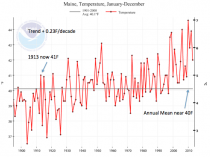9 Oct 2018
In its latest hysterical bulletin, the UN’s Intergovernmental Panel on Climate Change (IPCC) has urged that we need to spend $2.4 trillion a year between now and 2035 to avoid the potentially catastrophic consequences of ‘climate change.’
But the truth is that ‘climate change’ - at least as perceived by the IPCC - is bunk and all that expenditure (which, added up, amounts to a sum greater than the entirety of global GDP) would be a complete waste of money.
Or, as Professor Richard Lindzen, arguably the world’s greatest expert on the subject rather more elegantly put it in a lecture in London last night:
An implausible conjecture backed by false evidence and repeated incessantly has become politically correct ‘knowledge,’ and is used to promote the overturn of industrial civilization.
Lindzen, who for 30 years was Alfred P. Sloan Professor of Meteorology at the Massachusetts Institute of Technology, is probably the scientist most loathed and feared by the climate alarmist establishment. That’s because he knows the subject rather better than they do and has never been bested in argument.
He is withering in his contempt for man-made global warming theory, as he demonstrated in some scientific detail at the annual lecture of the Global Warming Policy Foundation in London, hosted by its president (Margaret Thatcher’s Chancellor of the Exchequer) Lord Lawson.
You can read the full text here.
The global warming scare has little to do with science, Lindzen began by noting, but is rather the product of ignorance of science.
Hence his lecture title: Global Warming for the Two Cultures.
This was a reference to the influential lecture given in the Fifties by the novelist and physical chemist CP Snow in which he decried the scientific ignorance among the supposedly educated elite.
Little has changed since, said Lindzen:
While some might maintain that ignorance of physics does not impact political ability, it most certainly impacts the ability of non-scientific politicians to deal with nominally science-based issues. The gap in understanding is also an invitation to malicious exploitation. Given the democratic necessity for non-scientists to take positions on scientific problems, belief and faith inevitably replace understanding, though trivially oversimplified false narratives serve to reassure the non-scientists that they are not totally without scientific ‘understanding.’ The issue of global warming offers numerous examples of all of this.
Later he singled out former Secretary of State John Kerry for especial scorn.
Former senator and Secretary of State John F. Kerry is typical when he stated, with reference to greenhouse warming, ‘I know sometimes I can remember from when I was in high school and college, some aspects of chemistry or physics can be tough. But this is not tough. This is simple. Kids at the earliest age can understand this’. As you have seen, the greenhouse effect is not all that simple. Only remarkably brilliant kids would understand it. Given Kerry’s subsequent description of climate and its underlying physics, it was clear that he was not up to the task.
Lindzen’s scientific case against the man-made global warming scare is essentially this: the world’s climate is a chaotic system whose workings, even after decades of intense study and billions of dollars of research funding, scientists have but barely begun to comprehend. Yet here they are deciding on the basis of no convincing evidence to pin the blame on just one of the many contributory elements to climate - carbon dioxide - and trying to persuade us that this trace gas is somehow the master control knob.
This notion is so ridiculous, he said, it is close to “magical thinking”.
Now here is the currently popular narrative concerning this system. The climate, a complex multifactor system, can be summarized in just one variable, the globally averaged temperature change, and is primarily controlled by the 1-2% perturbation in the energy budget due to a single variable - carbon dioxide - among many variables of comparable importance. This is an extraordinary pair of claims based on reasoning that borders on magical thinking. It is, however, the narrative that has been widely accepted, even among many sceptics.
Until the late 80s, not even climate scientists subscribed to this theory. It only took off for political reasons and because there was so much money to be made from it.
When, in 1988, the NASA scientist James Hansen told the US Senate that the summer’s warmth reflected increased carbon dioxide levels, even Science magazine reported that the climatologists were sceptical. The establishment of this extreme position as dogma during the present period is due to political actors and others seeking to exploit the opportunities that abound in the multi-trillion dollar energy sector.
Elites are much more susceptible to this nonsense than ordinary people.
As Lindzen explained, elites are less interested in truth than in what is convenient.
1. They have been educated in a system where success has been predicated on their ability to please their professors. In other words, they have been conditioned to rationalize anything.
2. While they are vulnerable to false narratives, they are far less economically vulnerable than are ordinary people. They believe themselves wealthy enough to withstand the economic pain of the proposed policies, and they are clever enough to often benefit from them.
3. The narrative is trivial enough for the elite to finally think that they ‘understand’ science.
4. For many (especially on the right), the need to be regarded as intelligent causes them to fear that opposing anything claimed to be ‘scientific’ might lead to their being regarded as ignorant, and this fear overwhelms any ideological commitment to liberty that they might have.
None of these factors apply to ‘ordinary’ people. This may well be the strongest argument for popular democracy and against the leadership of those ‘who know best.’
The scientists, meanwhile, don’t know nearly as much as they pretend they know. And in any case, many of them have been corrupted by money or their left-wing politics.
1. Scientists are specialists. Few are expert in climate. This includes many supposed ‘climate scientists’ who became involved in the area in response to the huge increases in funding that have accompanied global warming hysteria.
2. Scientists are people with their own political positions, and many have been enthusiastic about using their status as scientists to promote their political positions (not unlike celebrities whose status some scientists often aspire to). As examples, consider the movements against nuclear weapons, against the Strategic Defense Initiative, against the Vietnam War, and so on.
Scientists are also acutely and cynically aware of the ignorance of non-scientists and the fear that this engenders.
But what about all the scary “proof” that global warming is happening? Lindzen has no truck with any of it.
What about the disappearing Arctic ice, the rising sea level, the weather extremes, starving polar bears, the Syrian Civil War, and all the rest of it? The vast variety of the claims makes it impossible to point to any particular fault that applies to all of them. Of course, citing the existence of changes - even if these observations are correct (although surprisingly often they are not) - would not implicate greenhouse warming per se. Nor would it point to danger. Note that most of the so-called evidence refers to matters of which you have no personal experience. Some of the claims, such as those relating to weather extremes, contradict what both physical theory and empirical data show. The purpose of these claims is obviously to frighten and befuddle the public, and to make it seem like there is evidence where, in fact, there is none.
Just to repeat that last important point: Lindzen believes that there is no real-world evidence that supports man-made global warming theory. None.
Lindzen concluded:
What we will be leaving our grandchildren is not a planet damaged by industrial progress, but a record of unfathomable silliness as well as a landscape degraded by rusting wind farms and decaying solar panel arrays. False claims about 97% agreement will not spare us, but the willingness of scientists to keep mum is likely to much reduce trust in and support for science. Perhaps this won’t be such a bad thing after all - certainly as concerns ‘official’ science.
There is at least one positive aspect to the present situation. None of the proposed policies will have much impact on greenhouse gases. Thus we will continue to benefit from the one thing that can be clearly attributed to elevated carbon dioxide: namely, its effective role as a plant fertilizer, and reducer of the drought vulnerability of plants. Meanwhile, the IPCC is claiming that we need to prevent another 0.5C of warming, although the 1C that has occurred so far has been accompanied by the greatest increase in human welfare in history. As we used to say in my childhood home of the Bronx: ‘Go figure’.
---------
NOTE:
To abide by the IPCC report recommendations for taxing carbon production, to fill up your gas tank (12 gallons) in 2030 (just 11 years away), it would cost you over $600 each time you went to the gas station.
By John Droz
Yesterday a major study was released, that concluded that wind turbines cause more atmospheric warming than using coal does!
There have been other studies that have come to this conclusion (e.g. here), but maybe since this came from Harvard, more people will pay attention to it…
This is a good time to step back and look at the current Wind Energy Scorecard. Studies from independent experts (see prior Newsletters) have concluded the following:
1: Global Warming: Wind energy results in more warming than Coal does.
2: Climate Change: Wind energy produces more CO2 than Gas or Nuclear does.
3: Ratepayer Cost: Wind energy is 45 times the cost of conventional electrical energy sources.
4: Local Economics: Wind energy is likely a net economic loser to a host community
5: Health: Wind energy can cause severe health consequences to nearby residents.
6: Environmental: Wind energy has multiple major environmental impacts.
7: Jobs: Wind energy is net jobs liability.
8: Fossil Fuels: Wind energy assures a continued reliance on fossil fuels.
9: Sustainability: Wind energy has major dependence on unsustainable components (e.g. rare earths).
10: National Security: Wind energy can adversely affect the missions and operational readiness of military facilities, undermining our national security.
When we objectively look at the Big Picture, it is quite clear that there are no NET benefits from using wind energy. How did we go down such a losing path?
Because our energy policies were written by special-interest lobbyists, and these policies were NOT based on real Science.
As the well-known song says “...when will we ever learn?”
John Droz, jr.
physicist & citizen advocate
Note 1: We recommend reading the Newsletter on your computer, not your phone. Some documents (e.g. PDFs) are easier to read on a computer. We’ve tried to use common fonts, etc to minimize issues.
Note 2: Our intention is to put some balance into what most people see from the mainstream media about energy and environmental issues… As always, please pass this on to open-minded citizens, and on your social media sites. If there are others who you think would benefit from being on our energy & environmental email list, please let me know. If at any time you’d like to be taken off this list, simply send me an email saying that.
Note 3: This Newsletter is intended to supplement the material on our website, WiseEnergy.org. The most important page there is the Key Documents page.
Note 4: I am not an attorney, so no material appearing in any of the Newsletters (or our WiseEnergy.org website) should be construed as giving legal advice. My recommendation has always been: consult a competent attorney when you are involved with legal issues.
Warmist ‘Climatologists’ from Hollywood and the political world stepped between the needles and poop on the street in San Francisco to have a conference on climate change, attacking Trump and republicans for their neglect of their global governance based agenda that has the big lie about climate change has its primary foundation. A rebuttal was held in SFO with real scientists fact checking the fantasy.
---------------
UPDATE from Camp Constitution 2018 - 4 wonderful videos
----------------------
Americans came up with 36 answers to a Gallup poll asking the biggest problem currently facing the country, and no one answered “climate change,” with only two percent even mentioning the environment at all, Gallup revealed last week.
In a random poll of 1033 U.S. adults, immigration topped the list as the greatest problem faced by the United States at this moment, with 22 percent offering that response. While 17 percent responded that dissatisfaction with government was the biggest issue, others proposed race relations, national disunity, healthcare, and family decline.
Missing from Gallup’s list of causes garnering at least 3 percent of responses was the vague category of “Environment/Pollution,” which drew only 2 percent.
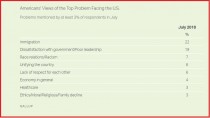
Gallup on most important problem facing U.S.
The new poll seems to signal a major disconnect between certain progressive leaders and the American people at large.
Last month, for instance, the Berkeley City Council issued a resolution declaring a worldwide climate emergency, calling it “the greatest crisis in history” after evoking memories of World War II.
“The United States of America has disproportionately contributed to the climate and ecological crises and to preventing a transition away from fossil fuels, and Americans thus bear an extraordinary responsibility to solve the crises,” the text reads.
While World War II involved the slaughter of six million as well as tens of millions of casualties, yet somehow the Berkeley City Council believes it was a lesser evil than the overarching problem of climate change, saying that the earth is “already too hot for safety and justice.”
Former President Barack Obama famously told the U.S. Coast Guard in 2015 that his administration considered climate change to be the most severe threat to national security.
“I am here today to say that climate change constitutes a serious threat to global security, an immediate risk to our national security, and, make no mistake, it will impact how our military defends our country,” the president told graduates of the Coast Guard Academy.
The following year, U.S. Secretary of State John Kerry compared the effects of climate change to Islamic terrorism, suggesting that the two pose an equivalent danger to the peoples of the world.
“Yesterday, I met in Washington with 45 nations - defense ministers and foreign ministers - as we were working together on the challenge of Daesh, ISIL, and terrorism,” Kerry said at the Vienna summit. “It’s hard for some people to grasp it, but what we - you - are doing here right now is of equal importance because it has the ability to literally save life on the planet itself.”
In May of this year, the United Nations went even further, declaring “climate change” to be the greatest global menace facing humanity.
“Climate Change is the single biggest threat to life, security and prosperity on Earth,” said UN Climate Change Executive Secretary Patricia Espinosa at the roll-out of their yearly report.
“This annual report shows how UN Climate Change is doing everything it can to support, encourage and build on the global response to climate change,” Espinosa said, adding that “UN Climate Change’s mandate is to lead and support the global community in this international response, with the Paris Agreement and the Convention being the long-term vehicles for united global climate action.”
---------
Climate ‘worry’ ranks at bottom of New York Times survey - ‘Worry about climate change’ at 17th out of 18 reasons for not having kids
Climate Depot note: The New York Times survey found that climate ‘worry’ comes in at 11% - 2nd to last out of 18 reasons cited - for why young adults are not having kids. So much for all the claims that people were forgoing having kids due to climate fears! (Flashback: A weatherman breaks down in tears and considers having a vasectomy, vows NEVER to fly again due to grim UN climate report: Eric Holthaus tweeted ‘no children, happy to go extinct’![]()
By The New York Times | Source: Morning Consult survey of 1,858 men and women ages 20 to 45
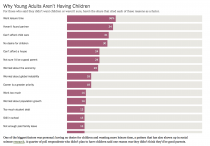
A new analysis of top-to-bottom (0-5,000 m or 3.1 miles) ocean heat content changes since the mid-1990s reveals that (a) large regions of the global ocean have undergone cooling, and (b) the overall net temperature change for 1994-2013 was a modest 0.02C.
In contrast, during the Holocene the oceans naturally warmed at a rate and magnitude several times greater than the last few decades, undermining claims that the modern era change is unusual or unprecedented.
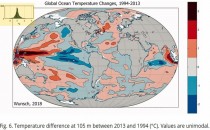
Global Warming = Ocean Warming
According to the United Nation’s Intergovernmental Panel on Climate Change (IPCC), the atmosphere accounts for only 1% of the heat energy change in the Earth system, whereas the 0-2,000 meter (0-1.2 miles) layer of the ocean is where 93% of the globe’s overall heat/temperature change has occurred in recent decades.
“Ocean warming dominates the total energy change inventory, accounting for roughly 93% on average from 1971 to 2010 (high confidence).
“The upper ocean (0-700 m) accounts for about 64% of the total energy change inventory.
“Melting ice (including Arctic sea ice, ice sheets, and glaciers) accounts for 3% of the total, and warming of the continents 3%. Warming of the atmosphere makes up the remaining 1%.’ (IPCC, 2013)
Deep Ocean Temperatures Cooling Since The 1990s
The IPCC chooses to exclude the layer of the ocean below 2,000 meters in their energy change inventories, even though about “52% of the ocean lies below 2,000 meters (1.2 miles) and about 18% below 3,600 meters (2.2 miles)” (Wunsch and Heimbach, 2014).
Perhaps the reason the deep ocean is disregarded is that recent analysis has revealed the deep oceans below 2,000 meters (1.2 miles) have been cooling since 1993.
“A very weak long-term [1993-2011] cooling is seen over the bulk of the rest of the ocean below that depth [2,000 m], including the entirety of the Pacific and Indian Oceans, along with the eastern Atlantic basin.” (Wunsch and Heimbach, 2014)
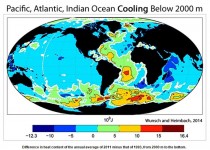
Image Source: (Wunsch and Heimbach, 2014)
Because of the cooling (thermal “retraction") occurring below 2,000 meters, the deep ocean removes a very uncertain -0.13 mm per year from global sea level change estimates (Llovel et al., 2014).
“Over the entire water column, independent estimates of ocean warming yield a contribution of 0.77 plus/minus 0.28 mm yr-1 in sea-level rise ... the deep ocean (below 2,000 m) contributes -0.13 plus/minus 0.72 mm yr-1 to global sea-level rise.” (Llovel et al., 2014)
Top-To-Bottom Global Ocean Temps Have Changed By 0.02C Since 1994...Large Regions Have Undergone Cooling
In a new paper, Harvard oceanographer Carl Wunsch provides an analysis of the overall temperature, salinity, and surface elevation changes in the global ocean for the 20 years between 1994-2013.
He focuses on the profound uncertainties in the data analysis and cautions that we still have much to learn about the ocean system.
Wunsch provides a novel assessment of the temperature data for the whole ocean (0-5,000 m), as the record doesn’t end at the 2,000-meter depth.
The results reveal that the global ocean has been cooling in some regions and warming in others for the last few decades, with an overall net change of 0.02C (~0.001C per year) during 1994-2013.
Read rest at No Tricks Zone
The Weather Channel turned 36 years old May 2nd.
In recognition of Independence Day, we have reduced the price to $17.76. Here Art Director Eddie (E.T.) Terrill talks about the book with a spoof of Neil Diamond’s America.
Most everyone has watched The Weather Channel at some time over the years. Have you ever wondered how the channel came about and what it took to become one of the most successful and well-recognized names in cable. The Founders and doers of the early days in ‘Weather Channel Pioneers’, give you a glimpse of these wild early days when it all came together. The updated website describes the adventure with videos and excerpts. It features a spoof video by a Pioneer honoring the Pioneers here and gone. Authors of the book include the late, great John Coleman, a friend, a true visionary and a fellow crusader for good climate science and many of the original staff.
John Coleman first told me about his dream of a 24x 7 cable weather network when I was working as a vacation fill-in weather producer for his weather shows for Good Morning America in the hot summer of 1980. Like a moth to a flame I was drawn to follow him. My family and I left my home in beautiful Vermont to work with John full-time on Good Morning America (GMA) out of the WLS studio in Chicago.
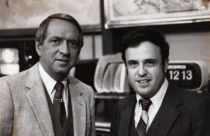
John was a veritable meteorological broadcaster rock star. He worked magic with chromakey green screen technology, pulling weather maps out of the air on WLS and GMA in a world mostly still using magnetic maps. He was winning awards for his on-air weather presentations.
I worked with him, 2 artists and two producers all night starting before midnight to produce 4 shows. As exciting as that was, John was frustrated by the fact the time allotted for each show was never guaranteed. If the news or sports segments ran over, weather took the hit on time.
He was convinced that what was needed was a 24x7 weather network like CNN was doing for news instead of the 15 to 18 minutes of weather/day on the networks and most local channels. We would always be there when they needed weather information - much like what the internet brings today
Over the year, he polished up the business plan and sometimes after his last morning show would fly off to a distant city to try and sell the idea, was rejected or even laughed at, flew home, changed his clothes and came to work. The other days after the last show, we’d go to the office and talk about his weather cable idea. What would we produce and present, how many forecasters and broadcasters and artists would we need, what companies would we team with for data and technology. What doesn’t exist we will need to create to do it right.
After a year of rejections though I was feeling a little like Sancho Panza following Don Quixote on his impossible dream quest.

But suddenly there was interest - Dow Jones then WGN - each time the interest and our excitement spiked then faded but then Landmark Communications entered the picture - with newspapers, radio and TV stations, cable systems, they had wanted to expand into cable programming to do news when the CEO developed cancer. While they waited, Ted Turner launched CNN. After the CEO recovered, they set up new venture groups to explore alternatives. One of the members was in a poker game with John Coleman and when John told him about his weather programming idea. He brought him to Landmark, they quickly worked out a deal and we were off and running.
That’s when it got crazy - we were off to Atlanta in October1981. John and I were very busy defining the product with the artists and producers. I hired two of my students to help me screen candidates for on and off camera positions. Resumes and tapes poured in during December and January. We hired many over the phone. The Pioneers reported for orientation March 1, we started practicing in April and launched May 2, 1982.
At start-up, amazingly we had 58 full-time broadcasters and forecasters with a total of 66 degrees and 450 years of meteorological experience.
We were state of the art for the time, but the technology was changing at a breakneck pace.
It was just the start of the computer graphics revolution in broadcasting and we lead the way with more than half a dozen such graphics systems including the first in the lines of high resolution paint boxes. Our artists, who originally did some graphics or art on paper that was then captured by cameras, quickly transitioned to using pen and palette. All graphics were funneled through a unique frame storage system.
The On Camera Meteorologists would load their shows and control the graphics display from the studio desk. There were no directors.
In parallel our technical staff worked furiously to be able to deliver the local weather, local forecasts and all severe weather NWS messages. We developed computer units that went into every cable system that knew its location and grabbed and displayed its information in formatted pages in the Local Weather and across the bottom of the screen. For it to work, we had to get the NWS to change how they formatted their local forecasts and warnings with address coding that allowed our systems to know what was important to them and where they get displayed.
When the weather was serious and it usually was somewhere in the nation, we were very serious on-air and worked very hard behind the scenes. When it was quiet, we let our hair down a little (it was the 1980s) and had some fun while still communicating information. The network in the early days was described as the first TV reality show, one of its appeals.
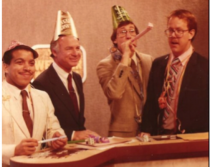
It really was an amazing journey that can’t be told in 1000 words, which is why we wrote a book.
In the book, we attempted to capture more of that story, that journey from one man’s vision to a shared vision of a large team of wonderful, courageous and talented individuals that came to Atlanta from all corners of the country in many different disciplines to undertake something special and unprecedented, unique people we call the Weather Channel Pioneers.
During this incredibly dynamic period, everyone went straight out, never entertaining the thought that what we wanted to do was impossible. We pulled off everyday miracles, overcame all obstacles and changed the paradigms for technology, weather data and warning delivery, graphics and on-air weather presentations. It was a time and a team like no other.
In the book, the Pioneers tell that story. It is about the early days not about what has transpired over the years.
http://Weatherchannepioneers.com is the web page that tells you more and links to the Amazon site where you can purchase the book. There are soft copy and e-book versions with over 120 pictures. We dedicated it to john Coleman. We hope if there is any profit, it will help support the reunion of the original Pioneers in 2019 in Atlanta. It may be the last time we will be together to revisit those magical days. We have already lost over a dozen of the originals’. We hope to do a video with the originals revisiting the days leading up to and following the successful launch in a network that set new paradigms for meteorology, presentation, technology for local data, forecast and warning delivery and so much more. It will bring back memories. Tom Skilling, who was a sounding board and helped John market the idea wrote this about the significance of TWC and on “his friend John Coleman’s passing:
“It was in a world which had never seen a weather channel---had no idea what such an entity would even look like---that John Coleman embarked on a mission which would occupy years of his life and end up revolutionizing the way meteorological information was communicated.”
Then Tom after reading the book responded:
Hi Joe,
I just had to write to tell you the book is amazing! What a tribute to John and what an amazing piece of work. As I read through it, all I could think about is about is the work you put into it. It shows! You have produced THE written record of one of the seminal advances in the field of meteorology--the creation of the Weather Channel. Your role in putting a staff for the channel was an achievement in and of itself. There was no model to follow, you broke new ground--and what a job you did.
That you to included me in this effort is an honor beyond words. THANK YOU, Joe ”
Jim Cantore, the face of todays’s TWC echoed Tom:
“Even though I didn’t start my TWC journey until 1986, I had no idea as a young man of 22 years what a wonderful opportunity I had been given to learn about life and meteorology from many of these TWC Pioneers. There are too many to name, but dozens of these men and women had a profound and lasting influence on the broadcaster I am today. What an incredible trip down memory lane revisiting the heart and soul of The Weather Channel as it was being born and as it became one of the most trusted brands in the world. These TWC pioneers didn’t just start a cable TV weather channel, they saved lives and created a mission of service which still resonates with millions of people to this day.”
- Jim Cantore
Memories....from TWC Art Director Eddie Terrill
Opinion: Paris is a climate fairy tale. It has always been more about money and politics than the environment
Two weeks of climate talks in Bonn ended last week without agreement on a draft negotiating text, the Washington Post reports. Developing countries demanded to know when the US$100-billion package promised to them as part of the Paris climate agreement would be forthcoming. Hopefully, the answer will be “never” and that will lead to the end of the deal.
Paris is a climate fairy tale. It has always been more about money and politics than the environment. Last year, U.S. President Donald Trump wisely announced that America would withdraw. For developed nations who still believe Paris is a viable plan, the prospect of a massive transfer of wealth under the guise of carbon reductions must seem less attractive without the U.S. to help foot the bill. Still, other world leaders seem irrationally committed to pursuing the real objectives of Paris: wealth redistribution, virtue signalling and globalist governance.
At the core of Paris, signed in 2015, and its 1992 umbrella document, the United Nations Framework Convention on Climate Change, is the principle of “common but differentiated responsibilities and respective capabilities.” The term means that developed countries are expected to go first, do more, and pay more. “To each according to his needs, from each according to his abilities,” as Marx wrote in a similar vein.
The objective is to rebalance resources. How much more must developed countries do and how many more dollars should they transfer? In the Paris negotiations, the parties confirmed a breathtaking minimum transfer of US$100 billion per year starting in 2020, with the expectation that higher amounts would be forthcoming as time progressed. In exchange, developing countries with high and accelerating carbon emissions, such as China and India, talked of reducing emissions, eventually, probably.
At the time the UNFCCC was adopted in 1992, the greater share of global emissions did indeed come from wealthier countries. However, that has not been the case since approximately 2007 and annual emissions from developing countries now dwarf those from the developed world. China became the world’s largest carbon emitter in 2006 and by some estimates emits twice what the U.S. does annually. Yet under Paris, China has said its annual emissions will keep growing until 2030.
As a matter of arithmetic, the lifestyles of people in Western countries do not pose nearly as acute a risk to greenhouse gas concentrations as even a small rise in per capita emissions from countries with “emerging” economies and enormous populations. The Paris consensus blames the West for the world’s problems while privileging countries that pose the most serious threats. If the danger is carbon emissions, it is developing countries that are now the biggest problem.
Paris is more a movement than a legal framework. It imagines the world as a global community working in solidarity on a common problem, making sacrifices in the common good, reducing inequality and transcending the negative effects of market forces. In this fable, climate change is a catalyst for revolution. It is the monster created by capitalism that will turn on its creator and bring the market system to the end of its natural life. A new social order will emerge in which market value no longer determines economic decisions. Governments will exercise influence over economic behavior by imposing “market-based mechanisms” such as carbon taxes and cap-and-trade systems. Enlightened leaders will direct energy use based upon social justice values and community needs. An international culture will unite peoples in a cause that transcends their national interests, giving way to the next stage of human society. Between the lines of the formal text, the Paris agreement reads like a socialist nightmare.
The regime attempts to establish an escalating global norm that requires continual updating, planning and negotiation. To adhere, governments are to supervise, regulate and tax the energy use and behavior of their citizens (for example, the Trudeau government’s insistence that all provinces impose a carbon tax or the equivalent, to escalate over time.) Yet for all of the domestic action it legitimizes, Paris does not actually require it. Like the US$100-billion pledge, reduction targets are outside the formal Paris agreement. They are voluntary; neither binding nor enforceable. Other countries have condemned Trump’s withdrawal and reaffirmed their commitment to Paris but many of them, including Canada, are not on track to meet even their initial promises. Global emissions are rising again.
If human action is not causing the climate to change, Paris is irrelevant. If it is, then Paris is an obstacle to actual solutions. If there is a crisis, it will be solved when someone develops a low-carbon energy source as useful and cheap as fossil fuels. A transition will then occur without government interventions and international declarations. Until then, Paris will fix nothing. It serves interests that have little to do with atmospheric concentrations of greenhouse gases. Will America’s repudiation result in its eventual demise? One can hope.
Bruce Pardy is Professor of Law at Queen’s University. This column is based upon an article forthcoming in the Journal of Environmental Law and Practice.
The demonization of the “miracle molecule,” carbon dioxide, continued last week with the announcement that its concentration had reached 410 parts per million (ppm). Nearly all reporting of this noted that this was the highest level in 800,000 years and predicted a host of associated climate calamities. While the current concentration of this vital gas is about 40% higher than at the start of the Industrial Revolution, unreported is that Earth has been suffering from steadily decreasing and perilously low concentrations of CO2. Until the consumption of fossil fuels began liberating this important gas from ancient rocks , the Earth had been flirting with dangerously low levels not seen for more than 600 million years.
During nearly all of Earth’s history, carbon dioxide concentration was at many multiples of our current level, averaging 2,600 ppm, or 6.5 times our current measurement. Forerunners of most of the plants we rely on for sustenance first appeared around 150 million years ago when CO2 levels were more than 2,000 ppm. Since that time CO2 has fallen steadily and precipitously.
In fact, at the end of the last ice age, carbon dioxide reached the dangerously low level of 182 ppm, thought to be the lowest since the Pre-Cambrian time period more than 600 million years ago. Why is it dangerous? Because 150 ppm is the lowest level at which plant life can survive. We came within a whisker of breaching that “line of death.” Until we began adding CO2 to the atmosphere, there was no guarantee that this horrific threshold would not be crossed in the future.
Rather than spreading fear of increasing carbon dioxide, we should be thankful that both the Earth and humanity are thriving, in part due to more CO2.
It has been long known that increasing CO2 benefits plant growth through the CO2 fertilization effect. Recognizing the benefits of this, greenhouses often increase CO2 to 1,500 ppm. Research from laboratory studies by the Center for the Study of CO2 and Global Change have documented that a 300 ppm rise in CO2 levels would increase plant biomass by 25 to 50%. This significant boost in plant productivity, along with a boost from lengthening growing seasons, means that we are better able to feed a hungry planet.
An additional significant benefit from this increasing CO2 fertilization is that the plants have smaller stomata (pores) and have lessened water needs. Less water used means that more stays in the ground and is leading to increasing soil moisture across much of the planet and a “greening” of the Earth. According to NASA, up to 50% of the Earth is “greening,” in part due to higher CO2 levels. This increased soil moisture is a primary cause for the long-term decrease in forest fires and droughts worldwide.
The benefits of increasing CO2 don’t stop with accelerating plant growth and increasing soil moisture. The biological impacts section of the 2014 white paper Climate change reconsidered II provided quite a lengthy list of additional benefits in addition to those mentioned above. The main points are listed below:
More CO2 makes plants grow faster and with less stress.
Forests are growing faster in response to increasing CO2.
More CO2 stimulates growth of beneficial bacteria in both soil and water.
CO2 fertilization, leading to more plant growth, means less erosion of topsoil.
More CO2 means bigger crop yields, and more and bigger flowers.
More CO2 fosters glomalin, a beneficial protein created by root fungi.
More CO2 helps plants to create natural repellants to fight insect predators.
Although I do not pretend to speak for the planet’s flora, I am quite certain that, if plants had a say in the matter, they would not lobby for reductions in CO2 levels. For plants, CO2 is food. They need more of it, not less.
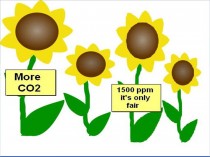 ]
]
By Jason Samenow, Capital Weather Gang April 19
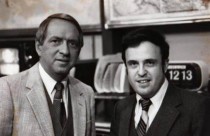
John Coleman, left, and Joe D’Aleo, right, in 1982. (WeatherChannelPioneers.com)
When the Weather Channel launched in 1982, its founder, John Coleman, knew he was on to the start of something important and something special. In its first night on air, he presciently told viewers that the channel would “become the nation’s primary source of weather information” and that it would “serve the nation with information presented in such a way that it adds greatly to the quality of American life and the enjoyment of the television set.”
Shaking off skepticism from the outside world that it could succeed amid initial growing pains, the Weather Channel quickly became one of America’s most beloved cable networks and, indeed, the most-watched source for weather news.
Before the Internet, it provided unrivaled access to weather information and helped keep people safe in severe storms. Its programming had a magnetic quality, which despite its repetitiveness, lured many viewers to watch for hours on end.
Joe D’Aleo was the first director of meteorology at the Weather Channel and helped Coleman launch the network in 1982. He and Coleman, who died earlier this year, recently released a new book on the cable channel’s earliest days, ”Weather Channel Pioneers, Tales From Those Who Made It Happen.”
The book chronicles the formative years of the successful network, spurred by a visionary, and supported by a deeply passionate and motivated team.
D’Aleo generously took the time to respond to my questions about the book effort and the Weather Channel’s beginnings. His answers were lightly edited for length and format.
Tell us about the motivation for writing the book and its intended audience.
John Coleman and I and a number of the original Weather Channel pioneers decided to tell the story of what it took to revolutionize the way weather information was disseminated to the nation, to tell the story of how the Weather Channel was started. We wanted to write the book before time silenced many of us. John passed away a few months after the writing began.
Many of the pioneers contributed their own experiences of working those early days, and this makes the book an entertaining and informative history, “the inside story” behind the founding of one of the country’s favorite cable channels.
The book tells our stories and memories of how we succeeded in what was thought to be an impossible quest. We invite readers to step back in time and experience what it was like to make that dream a success and imagine sharing that adventure. The pioneers were in many ways trailblazers. We can only imagine how many careers in meteorology we have influenced over the years.
The book should appeal to just about everyone who loves weather and remembers the Weather Channel over the years. The book, we hope, is also an inspiration to anyone who has ever had a dream to do something different or difficult to take that chance.
John Coleman is often credited as the Weather Channel’s founder, with funding support provided by Frank Batten Sr. and Landmark Communications. I understand you played a pivotal role in the channel’s launch, as well. Can you briefly walk us through who the key players were in getting the Weather Channel off the ground?
John Coleman first told me about his dream of a 24/7 cable weather network when I was working as a vacation fill-in weather producer for his weather shows for “Good Morning America” in the hot summer of 1980. Like a moth to a flame, I was drawn to follow him. My family and I left my home in beautiful Vermont to work with John full time on “Good Morning America” out of the WLS studio in Chicago.
John was a veritable meteorological broadcaster rock star. He worked magic with green screen technology [in which maps are electronically added to the image behind the broadcaster], pulling weather maps out of the air on WLS and “Good Morning America” - in a world mostly still using magnetic maps. He was winning awards for his on-air weather presentations in the early 1980s.
As exciting as that was, John was frustrated by the fact the time allotted for each show was never guaranteed. If the news or sports segments ran over, weather took the hit on time.
He was convinced that what was needed was a 24/7 weather network like what CNN was doing for news. We would always be there when they needed weather information - much like what the Internet and mobile technology brings today.
Over the years, John polished up the business plan and sometimes, after his last morning show, would fly off to a distant city to try to sell the idea. His idea routinely was rejected. John flew home, changed his clothes and came to work.
After a year of rejections, though, I was feeling a little like Sancho Panza following Don Quixote on his impossible dream quest.
But suddenly there was interest from a number of major media players including Landmark Communications, which owned newspapers, radio and TV stations and multiple cable systems. They had wanted to expand into cable programming to do news when the CEO, Frank Batten Sr., developed cancer.
After Frank recovered, they set up new venture groups to explore alternatives. One of the members was in a poker game with John Coleman, and when John told him about his weather programming idea, he brought him to Landmark. They quickly worked out a deal, and we were off and running.
That’s when it got crazy. We were off to Atlanta in October 1981. John and I were very busy defining the product with the artists and producers. We got busy hiring.
Resumes and [audition] tapes poured in during December and January. We hired many over the phone. The pioneers reported for orientation March 1, we started practicing in April and launched May 2, 1982.
At start-up, amazingly we had 58 full-time broadcasters and forecasters with 66 college degrees and 450 years of meteorological experience.
When the Weather Channel launched, what was the level of confidence it would succeed?
Though there were doubters, we were confident internally we would be meeting our viewers’ needs and would succeed. A National Weather Service survey indicated that TV was the main source of local weather information. This was true despite the fact that a typical station or network only devoted 15 to 18 minutes on an average broadcast day to weather coverage.
We had major challenges, though - the biggest was providing the local information that the viewers needed. Our technical staff worked furiously to be able to deliver the local weather, local forecasts and all severe weather messages.
For it to work, we had to get the Weather Service to change how they formatted their local forecasts and warnings with address coding that allowed our systems to know what was important to them and where they get displayed.
During this incredibly dynamic start-up period, everyone went straight out, never entertaining the thought that what we wanted to do was impossible. We pulled off everyday miracles, overcame all obstacles and, along the way, changed the paradigms for technology, weather data, forecast and warning delivery, meteorology and on-air weather presentations. It was a time and a team like no other.
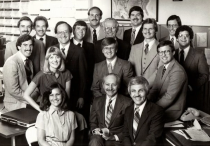
Some of the early Weather Channel meteorologists. (WeatherChannelPioneers.com)
What was the workplace culture like at the Weather Channel in its early days? What was a typical day like for you?
The workplace chemistry was generally very good, considering the fact that everyone had very significant workload responsibilities.
Our technology was state of the art for the time, but the technology was changing at a breakneck pace.
It was just the start of the computer graphics revolution in broadcasting, and we led the way with more than half a dozen such graphics systems. Our artists, who originally did some graphics or art on paper that was then captured by cameras, quickly transitioned to using pen and palette. All graphics were funneled through a unique frame storage system.
The on-camera meteorologists would load their shows and control the graphics display from the studio desk. There were no directors.
When the weather was bad, and it usually was somewhere in the nation, we were very serious on-air and worked very hard behind the scenes. When it was quiet, we let our hair down a little (it was the 1980s) and had some fun while still communicating information.
[The Weather Channel’s first attempt at a live shot in 1983 was a total bust]
The network in the early days was described as the first TV reality show, one of its appeals. Our viewers increasingly loved us. In 1983, a Nielsen survey showed that at least 40 percent of the cable households tuned in at least twice a day for an average of 28 minutes.
For me personally and our other managers in the operational departments, we had to deal with the stresses our staff that worked long days or nights or on rotating shifts faced. I knew from personal experience how difficult that is on the individuals and their families.
The biggest stressor for the “company” was financial. We had fixed costs to run the business. Despite very good ratings, viewer loyalty and increasing advertising sales, it wasn’t until the growing cable industry committed to providing subscriber fees that we turned the corner and became very profitable.
What are some of the book’s highlights and key messages that a reader will take away? What should a reader who obtains a copy look forward to?
There are many businesses that have been hugely successful by changing the paradigm and meeting needs in a new way, and the Weather Channel was one of those. It takes vision, teamwork and full commitment.
The “Weather Channel Pioneers” book tells one such story from one man’s vision that became a shared vision of an incredible and dedicated team and then a full commitment and follow-through by the entire staff to achieve success. There are amusing anecdotes from the early days as we were breaking new ground the reader will enjoy.
We know John Coleman tragically passed away before this book was published. Can you briefly talk about his contributions to the book effort?
[When I last saw John in 2017], his health was declining, and I decided, after discussions with some of my closest Weather Channel pioneer friends, that we needed to do that book that captures our story now. We were pleased when John agreed.
John wrote his entire section and did some editing on the early versions before the combination of this season’s nasty flu and his emphysema sadly took him from us.
What is your impression of the Weather Channel as a network today? Do you watch it? Do you feel like it is fulfilling your early visions? What might you change about it to make it better?
I watch little television, keeping myself busy with seven-days-per-week forecasting for WeatherBELL Analytics, along with my compadre Joe Bastardi and our other great staff. The Weather Channel realized years ago that the Internet and mobile technology would cut into ratings and focused more of their energies on those areas. That was the right move.
I hope the network does as their new owners promise, recommit to being the full-time weather source on TV.
The Weather Channel’s first attempt at a live shot in 1983 was a total bust
New website describes the book. With videos and excerpts. It features a spoof video by a Pioneer honoring the Pioneers here and gone.
The Weather Channel turns 36 years old May 2nd.
Millions of viewers have watched The Weather Channel over the years. You are probably one of them. Have you ever wondered how the channel came about and what it took to become one of the most successful and well-recognized names in cable. The Founders and doers of the early days have written a book called Weather Channel Pioneers, which answers those questions.
John Coleman first told me about his dream of a 24x 7 cable weather network when I was working as a vacation fill-in weather producer for his weather shows for Good Morning America in the hot summer of 1980. Like a moth to a flame I was drawn to follow him. My family and I left my home in beautiful Vermont to work with John full-time on Good Morning America (GMA) out of the WLS studio in Chicago.

John was a veritable meteorological broadcaster rock star. He worked magic with chromakey green screen technology, pulling weather maps out of the air on WLS and GMA in a world mostly still using magnetic maps. He was winning awards for his on-air weather presentations.
I worked with him, 2 artists and two producers all night starting before midnight to produce 4 shows. As exciting as that was, John was frustrated by the fact the time allotted for each show was never guaranteed. If the news or sports segments ran over, weather took the hit on time.
He was convinced that what was needed was a 24x7 weather network like CNN was doing for news instead of the 15 to 18 minutes of weather/day on the networks and most local channels. We would always be there when they needed weather information - much like what the internet brings today
Over the year, he polished up the business plan and sometimes after his last morning show would fly off to a distant city to try and sell the idea, was rejected or even laughed at, flew home, changed his clothes and came to work. The other days after the last show, we’d go to the office and talk about his weather cable idea. What would we produce and present, how many forecasters and broadcasters and artists would we need, what companies would we team with for data and technology. What doesn’t exist we will need to create to do it right.
After a year of rejections though I was feeling a little like Sancho Panza following Don Quixote on his impossible dream quest.

But suddenly there was interest - Dow Jones then WGN - each time the interest and our excitement spiked then faded but then Landmark Communications entered the picture - with newspapers, radio and TV stations, cable systems, they had wanted to expand into cable programming to do news when the CEO developed cancer. While they waited, Ted Turner launched CNN. After the CEO recovered, they set up new venture groups to explore alternatives. One of the members was in a poker game with John Coleman and when John told him about his weather programming idea. He brought him to Landmark, they quickly worked out a deal and we were off and running.
That’s when it got crazy - we were off to Atlanta in October1981. John and I were very busy defining the product with the artists and producers. I hired two of my students to help me screen candidates for on and off camera positions. Resumes and tapes poured in during December and January. We hired many over the phone. The Pioneers reported for orientation March 1, we started practicing in April and launched May 2, 1982.
At start-up, amazingly we had 58 full-time broadcasters and forecasters with a total of 66 degrees and 450 years of meteorological experience.
We were state of the art for the time, but the technology was changing at a breakneck pace.
It was just the start of the computer graphics revolution in broadcasting and we lead the way with more than half a dozen such graphics systems including the first in the lines of high resolution paint boxes. Our artists, who originally did some graphics or art on paper that was then captured by cameras, quickly transitioned to using pen and palette. All graphics were funneled through a unique frame storage system.
The On Camera Meteorologists would load their shows and control the graphics display from the studio desk. There were no directors.
In parallel our technical staff worked furiously to be able to deliver the local weather, local forecasts and all severe weather NWS messages. We developed computer units that went into every cable system that knew its location and grabbed and displayed its information in formatted pages in the Local Weather and across the bottom of the screen. For it to work, we had to get the NWS to change how they formatted their local forecasts and warnings with address coding that allowed our systems to know what was important to them and where they get displayed.
When the weather was serious and it usually was somewhere in the nation, we were very serious on-air and worked very hard behind the scenes. When it was quiet, we let our hair down a little (it was the 1980s) and had some fun while still communicating information. The network in the early days was described as the first TV reality show, one of its appeals.

It really was an amazing journey that can’t be told in 1000 words, which is why we wrote a book.
In the book, we attempted to capture more of that story, that journey from one man’s vision to a shared vision of a large team of wonderful, courageous and talented individuals that came to Atlanta from all corners of the country in many different disciplines to undertake something special and unprecedented, unique people we call the Weather Channel Pioneers.
During this incredibly dynamic period, everyone went straight out, never entertaining the thought that what we wanted to do was impossible. We pulled off everyday miracles, overcame all obstacles and changed the paradigms for technology, weather data and warning delivery, graphics and on-air weather presentations. It was a time and a team like no other.
In the book, the Pioneers tell that story.
http://Weatherchannepioneers.com is the web page that tells you more and links to the Amazon site where you can purchase the book. There are soft copy and e-book versions with over 120 pictures. We dedicated it to john Coleman who sadly passed away late this winter. If you prefer the ebook, go here.
----------
Thanks to my friend Anthony for being one of the early reviewers and his kind words. Ironically the day the book was released, The Weather Channel was sold again.
The book has many amusing anecdotes and untold stories by the ‘Weather Channel Pioneers in their own words along with many photos. Those of you who enjoyed TWC years ago will see people you will remember. We invite you to step back in time and experience what it was like to make that dream a success and imagine sharing in that adventure.
---------
Anthony Watts / 3 days ago March 22, 2018
My friend Joe D’Aleo (co-founder of the Weather Channel with the late great John Coleman) have written a fantastic book. John made a lot of headway on the book just before he died, and Joe took it to completion. Joe writes:
“The Weather Channel was the realization of a dream of one incredible man that became a shared vision of a large team of wonderful, courageous and talented individuals that assembled from all corners of the country in many different disciplines to undertake something special and unprecedented.”

“We like to call these unique people the “Weather Channel Pioneers”. To pave that road to success in the early days, we pulled off everyday miracles, overcame many obstacles and changed the paradigms for technology, the delivery of life-saving information and on-air weather presentations all while informing and entertaining our viewers. It was a time and a team like no other. In this book, we immortalize that effort with their personal stories and memories of that incredible journey.”
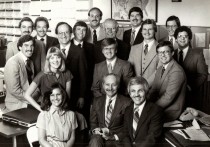
TWC on-air staff, circa 1982
Current Weather Channel meteorologist, Jim Cantore, offered this review:
“Even though I didn’t start my TWC journey until 1986, I had no idea as a young man of 22 years what a wonderful opportunity I had been given to learn about life and meteorology from many of these TWC Pioneers. There are too many to name, but dozens of these men and women had a profound and lasting influence on the broadcaster I am today. What an incredible trip down memory lane revisiting the heart and soul of The Weather Channel as it was being born and as it became one of the most trusted brands in the world. These TWC pioneers didn’t just start a cable TV weather channel, they saved lives and created a mission of service which still resonates with millions of people to this day.”
I had a hand in the early TWC success. I’ll never forget the first time I saw TWC. It was at the county fair at the business pavilion, and a local company was selling “satellite TV”.
They had their display tuned to “The Weather Channel” and I must have stood there a full 30 minutes watching it. I was mesmerized. I knew then I wanted to be a part of it somehow, and later, my own dream came true when I provided equipment to initially get WSI satellite images into their Quantel still store (which handled the on-air sequences) and later via an IBM PC, which had the very first PC based computer frame-buffer graphics card with a Genlock capable (used to synchronize to the other TV devices) RGB to NTSC encoder to make composite video and keep it synchronized with the other video devices in the studio. It’s something that I was thrilled to design.

Note the “breadboarding area” on the top card. The reason was that some video switchers (like models from Grass Valley Group) had a specific requirement for horizontal blanking width, which sometimes differed based on the setup at the TV studio. In the digital to analog world, sometimes I’d have to design analog circuitry “on the fly” to compensate for these nuances so that when this device was switched to while in the chroma-key, there wasn’t a slight horizontal tick, but a seamless transition. Back then, making NTSC television work reliably was a bit of an art-form.
That story is in the book, as told by John Coleman. There’s many other stories where they had to improvise and create things that didn’t exist. Mind you, when TWC first started, the way National Weather Service disseminated weather information was by Teletype running at 58.65 baud (there’s a whole untold story behind that weird number too) and wide-format wet paper fax machines sold by Alden Corporation, which produced output that looked like this:
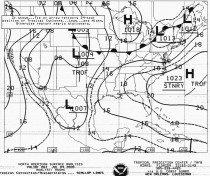
weatherfax.jpg
What TWC did back then and the demands they made, changed the way the NWS did business with the public - and for the better.
I was honored to be working with the TWC team back then, and while I would have loved to be on-air, circumstances at the time just didn’t mesh. But I did gain two life-long friends; Joe D’Aleo and John Coleman, who joined me in the fight against the often ridiculous climate change arguments we fight here daily.

Left, John Coleman Right, Joe D’Aleo
This book is dedicated to the pioneers. It’s a profile in vision, innovation, and courage. I highly recommend it.
Available on Amazon, HERE.
-------
Note: Buy Joe Bastardi’s The Climate Chronicles in the same order and get free shipping even if you are not on Amazon Premium.
Pompeo, Trump and the Paris Climate Agreement
By John Stossel
Trump announces he will pull out of Paris Climate Accord. President blasts the agreement as ‘unfair at the very highest levels’.
President Trump’s pick to be the new secretary of state, Mike Pompeo, is not a fan of the Paris climate agreement, the treaty that claims it will slow global warning by reducing the world’s carbon dioxide emissions. Politicians from most of the world’s nations signed the deal, and President Obama said “we may see this as the moment that we finally decided to save our planet.“‘
That’s dubious.
Trump wisely said he will pull America out of the deal. He called it a “massive redistribution of United States wealth to other countries.”
Unfortunately, Trump often reverses himself.
The climate change lobby has been trying to change Trump’s mind. Al Gore called his stance “reckless and indefensible.” Most of the media agree. So do most of my neighbors in New York.
That’s why it’s good that Pompeo opposes the Paris deal. Such treaties are State Department responsibilities. Pompeo is more likely to hold Trump to his word than his soon-to-be predecessor Rex Tillerson, who liked the agreement.
The Paris accord is a bad deal because even if greenhouse gases really are a huge threat, this treaty wouldn’t do much about them.
I’ll bet Al Gore and most of the media don’t even know what’s in the accord. I didn’t until I researched it for this week’s YouTube video.
Manhattan Institute senior fellow Oren Cass is the rare person who actually read the Paris accord.
Cass tells me it’s “somewhere between a farce and a fraud.” I interviewed him for a video project I am doing with City Journal, a smart policy magazine that often makes the case for smaller government. “You don’t even have to mention greenhouse gases in your commitment if you don’t want to. You send in any piece of paper you want.”
The Paris accord was just political theater, he says. “They stapled it together and held it up and said, “This is amazing!"”
The media announced that China and India made major commitments.
In truth, says Cass, “They either pledged to do exactly what they were already going to do anyway, or pledged even less. China, for instance said, ‘we pledge to reach peak emission by about 2030.’ Well, the United States government had already done a study to guess when Chinese emissions would peak, and their guess was about 2030.”
In other words, China simply promised to do what was going to happen anyway.
“China was actually one of the better pledges,” says Cass. “India made no pledge to limit emissions at all. They pledged only to become more efficient. But they proposed to become more efficient less quickly than they were already becoming more efficient. So their pledge was to slow down.”
It’s hard to see how that would help the planet.
“My favorite was Pakistan, whose pledge was to ‘Reach a peak at some point after which to begin reducing emissions,’” says Cass. “You can staple those together, and you can say we now have a global agreement, but what you have is an agreement to do nothing.”
However, Cass says one country did make a serious commitment. “The one country that showed up in Paris with a very costly, ambitious target was the United States. President Obama took all the zero commitments from everybody else but threw in a really expensive one for us.”
Obama pledged to reduce emissions by 26 percent. If that ever happened, it would squash America’s economy.
Nevertheless, when Trump said he was leaving the Paris accord, he was trashed by politicians around the world.
The UK’s Theresa May was “dismayed,” and Obama said, “This administration joins a handful of nations that reject the future.”
Cass counters that if “the future is worthless climate agreements… we should be proud to reject.”
Don’t get me wrong: The Earth has been warming, and humans probably contribute to it.
But the solution isn’t to waste billions by making emissions cuts in America while other countries do nothing.
Trump was right to repudiate this phony treaty. It’s good that Pompeo is around to remind him of that.
Apocalypse now?
By Cal Thomas
Tribune Content Agency
Since the beginning of recorded history there have been end of the world predictions. In recent years we have had radio preachers, politicians and scientists declare with certainty that the world would soon end, either because of our decadent lifestyle, or because of “global warming,” now known as “climate change.”
Responses to these Chicken Little declarations have ranged from people hiding in caves to the most recent announcement by Costco that it has a doomsday meal kit for sale. The cost is $6,000. The online listing says the kit contains 36,000 servings of food that will feed a family of four for one year.
Marc Morano’s new book “The Politically Incorrect Guide to Climate Change” (Regnery Publishing) is just in time to refute the argument that “climate change” will destroy all life on Earth. It is a mark of Morano’s dark humor that he features as an “endorsement” of the book a comment by the liberal Daily Kos, which calls Morano “evil personified.”
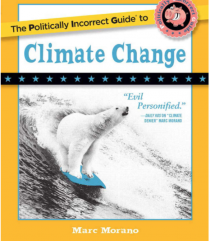
The book is a point-by-point takedown of the predictions of disaster made by the climate change movement, none of which have materialized, but when one is part of a cult, facts don’t matter.
In the book’s foreword, the late John Coleman, who was a meteorologist, TV weatherman and co-founder of The Weather Channel, writes: “We meteorologists are well aware of how limited our ability is to predict the weather. Our predictions become dramatically less reliable as they extend into the future. When we try to predict just a few weeks into the future our predictions become increasingly inaccurate. Yet the ‘climate change’ establishment that now dominates the UN bureaucracy and our own government science establishment claim that they can predict the temperature of the Earth decades into the future.”
Coleman then gets to the heart of the issue: ‘Their global warming scare is not driven by science; it is now being driven by politics. So today anybody who defies the prevailing ‘climate change’ scare puts his career and his reputation into extreme danger.”
Among the facts revealed in Morano’s book are these: The world spends $1 billion a day to “prevent” global warming; A UN scientist says the “97 percent consensus” on global warming was “pulled from thin air,” presumably hot air from many politicians; scientific organizations claim climate change ‘consensus,’ but have not polled their members; climate policies are not helping, but “crushing the world’s poor”; The Paris climate accord theoretically postpones global warming by just four years, but will cost $100 trillion if fully implemented; climate change has been blamed for prostitution, barroom brawls, airplane turbulence and war; one climate activist is quoted as saying we should “protect our kids by not having them”; recent “hottest year” claims are based on statistically meaningless year-to-year differences; Antarctica is actually gaining, not losing ice; carbon dioxide levels today are 10 times lower than in some past Ice Ages.
Morano argues that the debate over climate change is not settled, as many claim. Science is never settled and apparently neither is the politics of climate change, which is being advanced by people who want more control over every aspect of our lives.
Real scientists who specialize in climate and related fields are quoted in the book. These are voices we rarely, if ever, see mentioned in the mainstream media because the media are part of the collusion.
Read this book and you will become an informed climate change denier, armed with arguments and facts to counter the propaganda being pushed by climate change fanatics. It will also save you $6,000 the next time you visit Costco.
(Readers may email Cal Thomas at tcaeditors@tribpub.com.)
See Global warming skeptic keeps his cool amid hysteria
Marc Morano’s “Politically Incorrect Guide to Climate Change” uses humor to battle alarmists. See story here.
--------------
The Beast form the East - Siberian cold brought up the 3 feet of snow to the UK (drifts topping 8 feet near Dublin, Ireland).
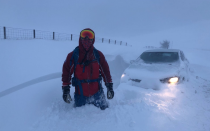
See even the NYT could not ignore this.
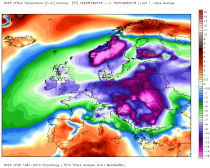
This winter featured snow in North Africa where alarmists predicted warmth and expanding drought and desert. Instead colder temperatures and increasing precipitation and shrinking desert has been observed.
By JAMES DELINGPOLE 20 Feb 2018
The National Oceanic and Atmospheric Administration (NOAA) has yet again been caught exaggerating ‘global warming’ by fiddling with the raw temperature data. This time, that data concerns the recent record-breaking cold across the northeastern U.S. which NOAA is trying to erase from history.
If you believe NOAA’s charts, there was nothing particularly unusual about this winter’s cold weather which caused sharks to freeze in the ocean and iguanas to drop out of trees.
Here is NOAA’s January 2018 chart for Northeast U.S. - an area which includes New England along with NY, PA, NJ, DE and MD.
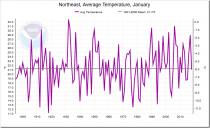
You’d never guess from it that those regions had just experienced record-breaking cold, would you?
That’s because, as Paul Homewood has discovered, NOAA has been cooking the books. Yet again - presumably for reasons more to do with ideology than meteorology - NOAA has adjusted past temperatures to look colder than they were and recent temperatures to look warmer than they were.
We’re not talking fractions of a degree, here. The adjustments amount to a whopping 3.1 degrees F. This takes us well beyond the regions of error margins or innocent mistakes and deep into the realm of fiction and political propaganda.
Homewood first smelt a rat when he examined the New York data sets.
He was particularly puzzled at NOAA’s treatment of the especially cold winter that ravaged New York in 2013/14, which he describes here:
The cold weather really began on Jan 2nd, when an Arctic front descended across much of the country, and extended well into March.
The NWS wrote at the end of the winter:
The winter of 2013-14 finished as one of the coldest winters in recent memory for New York State. Snowfall across Western and North Central New York was above normal for many areas, and in some locations well above normal. This winter comes on the heels of two previous mild winters, making the cold and snow this winter feel that much harsher.
Temperatures this winter finished below normal every month, and the January through March timeframe finished at least 4 degrees below normal for the two primary climate stations of Western New York (Buffalo and Rochester)…
Relentless cold continued through the month of January across the region.
So why, he wondered, did NOAA have this marked down as only the 30th coldest winter (since 1895) on its New York State charts, with a mean temperature of 16.9F?
Homewood compared the local records for January 1943 and January 2014 - months which, according to NOAA’s charts, had very similar average temperatures.
What he found was that NOAA’s charts were deeply inaccurate. The 2014 local temperatures had been adjusted upwards by NOAA and the 1943 local temperatures downwards.
He concludes:
On average the mean temperatures in Jan 2014 were 2.7F less than in 1943. Yet, according to NOAA, the difference was only 0.9F.
Somehow, NOAA has adjusted past temperatures down, relatively, by 1.8F.
Now, Homewood has given the same treatment to the most recent Big Freeze - the winter of 2017/2018.
Yet again, he has found that NOAA’s arbitrary adjustments tell a lie. They claim that January 2018 was warmer in the New York region than January 1943, when the raw data from local stations tells us this just isn’t true.
So at the three sites of Ithaca, Auburn and Geneva, we find that January 2018 was colder than January 1943 by 1.0, 1.7 and 1.3F respectively.
Yet NOAA say that the division was 2.1F warmer last month. NOAA’s figure makes last month at least 3.1F warmer in comparison with 1943 than the actual station data warrants.
He concludes:
Clearly NOAA’s highly homogenized and adjusted version of the Central Lakes temperature record bears no resemblance at all the the actual station data.
And if this one division is so badly in error, what confidence can there be that the rest of the US is any better?
Well indeed. The key point here is that while NOAA frequently makes these adjustments to the raw data, it has never offered a convincing explanation as to why they are necessary. Nor yet, how exactly their adjusted data provides a more accurate version of the truth than the original data.
One excuse NOAA’s apologists make is that weather stations are subject to changing environmental conditions. For example, when the station sited at Syracuse in 1929 was located at what was originally just a sparse aerodrome. Since then, however, as Homewood notes, it has grown into a large international airport with two runways servicing two million passengers a year. Its weather station readings therefore will certainly have been corrupted by the Urban Heat Island effect: that is, its temperature readings will have been artificially elevated by the warmth from the surrounding development and aircraft engines.
So you’d think, wouldn’t you, that to compensate for this NOAA would adjust the recent temperatures downwards. Instead, for no obvious reasons, it has adjusted them upwards.
This is a scandal. NOAA’s climate gatekeepers are political activists not honest scientists and the U.S. taxpayer has no business funding their propaganda.
Drain the swamp!
--------------
Recall the story we posted a few years ago about NOAA shenanigans in Maine. The original USHCN data set was downloaded in 2011 for a presentation. It showed no statistically significant trend (slightly negative) since 1895.
When asked to reprise the presentation a few years later, we update the chart from Climate at a Glance and found a very large -2.3F/decade warming accomplished by cooling the past.
The local newspaper (Portland Press Herald) did a story on how Maine was warming faster than any other state.
By James Wallace and Francis Menton, IBD
When President Trump calls the alarm surrounding climate change a hoax, he is fundamentally correct: there is no valid scientific basis for climate alarm. Climate alarmism is made possible by equal parts data manipulation and worthless climate models.
Now that Congress and the president are done with tax reform, many expect spending cuts and debt reduction to be up next. Given the huge and still increasing economic costs being imposed on the nation for no scientifically valid reason, we suggest a renewed focus on rapidly eliminating destructive carbon dioxide emission regulations.
For those not familiar, in December 2009 the Obama administration issued a report (the EF) that claimed to find atmospheric greenhouse gases (GHG) pose a “danger” to human health and welfare.
Despite President Trump’s statement that climate alarm is a “hoax,” nearly everyone Pruitt talks to - holdover officials at EPA, legions of academics receiving government funding, lobbying organizations like the Chamber of Commerce and National Association of Manufacturers, and even many energy industry executives - tells him that reconsidering the EF is a huge mistake because the scientific evidence supporting it is overwhelming.
Pruitt has proposed a year long, perhaps televised, Red/Blue debate to clarify the scientific situation. But before this lengthy process has even started, environmental groups and blue state AGs are already pummeling EPA in court with its own EF, winning victories that obstruct the administration’s efforts to grow America’s energy sector, and to enhance its economic and national security.
So, what is the actual science behind the EF? We confidently assert that in any Red/Blue evaluation of the science, where the Blue team supports the EF, the Blue team will lose badly.
“Warmists” claim a 97% scientific consensus regarding the hypothesized catastrophic impact of increased atmospheric concentrations of CO2 and other GHGs. But this illusion of consensus has only come about through misrepresentation of global temperatures and research results plus rigid enforcement of orthodoxy and refusal to debate for some two decades.
In accordance with the scientific method, the EF has been shown to be invalid at least three separate times over the past two years. One of us (Wallace) is the lead author of three scientific research reports that, each in a unique fashion, invalidated all of the lines of evidence on which EPA claimed to rely for its EF.
All three of these reports meet two criteria fundamental to the scientific method: (1) the authors’ mathematical/statistical modeling work can be easily replicated since the model results are shown, and all of the data utilized are stated in the research reports to be available from one of the authors; and (2) extensive peer review, with the distinguished, highly credentialed reviewers being publicly identified.
By contrast, the vast majority of the work on which EPA relied for the EF does not meet these two criteria, and therefore would be excluded from consideration in a scientifically proper reconsideration. Most important, our findings have never been invalidated by the massive climate alarm community.
As an illustration of the relevance of these findings, our June 2017 Research Report sought to validate the estimates of current and historical global average surface temperature (GAST) from NOAA, NASA, and the UK’s Hadley CRU, using the best available empirical data.
These official GAST estimates are a necessary foundation for EPA’s “lines of evidence” for its EF and are also the foundation for frequent government claims of record-setting temperatures. But this research found it impossible to conclude from the three GAST data sets that recent years have been the warmest ever. Instead, the conclusive findings were that the GAST data sets are simply not a valid representation of reality.
More specifically, in this research report, past changes in the previously officially reported historical data are quantified. It was found that each new version of GAST has nearly always exhibited a steeper warming linear trend over its entire history.
And, it was nearly always accomplished by each entity systematically removing the previously existing cyclical temperature pattern. This was true for all three entities providing GAST data measurement, NOAA, NASA and Hadley CRU.
Given the magnitude of each of the three entities’ historical data adjustments, and their removal of the previous officially-reported cyclical temperature patterns, the officially-reported data are now totally inconsistent with very considerable current, published and credible U.S and other temperature data.
With GAST data set validity being a necessary condition for the EF, it too is invalidated by these research findings. Therefore, EPA’s 2009 claim that CO2 is a pollutant has been decisively invalidated. The same conclusion is reached based on separate analyses in the other two research reports. Thus, the likelihood of this EF invalidation result being in error is nil.
For there to be a real global warming crisis, it is necessary that rising atmospheric GHG concentrations be proven to have a statistically significant impact on GAST. Collateral claims of danger from things like extreme weather events, droughts, floods, hurricanes and rising seas are fundamentally based on proof of that impact. But that proof has not been made.
The regulations based on the EF that President Obama imposed (e.g., the Clean Power Plan) cause huge and totally unnecessary costs to the economy in the range of hundreds of billions of dollars per year.
Given the vast economic costs to America of pursuing the suppression of fossil fuels, it makes no sense to insert a further one-year plus Red/Blue debate delay in granting reconsideration of the EF. Instead, the Red/Blue exercise should be held as a prompt, on-the-record legal reconsideration of the EF.
When this exercise is over, the American people finally will have been shown the truth about the shoddy, tendentious, and unscientific mangling of data that’s necessary to sustain the cult of climate alarm.
Wallace, Ph.D., is the lead author of numerous papers and legal briefs regarding EPA’s Endangerment Finding.
Menton is a lawyer who has submitted a petition calling on EPA to reopen its Endangerment Finding.
Michael Bastasch on February 1, 2018
A libertarian think tank has notified the Securities Exchange Commission (SEC) that California cities and counties may have inadvertently admitted to securities fraud in their global warming lawsuits against oil companies.
The Competitive Enterprise Institute (CEI) attorneys pointed out that localities’ suing a group of oil companies for current and future damages allegedly caused by global warming may have misled municipal bond investors.
“A number of California cities and counties have recently filed lawsuits against several oil and gas companies, claiming that these companies failed to disclose the alleged risks of climate change,” CEI attorneys Sam Kazman and Devin Watkins wrote to the SEC.
“However, in these lawsuits the plaintiff cities and counties apparently describe these climate risks in ways that are far different than how they described them in their own bond offerings. In our view, this inconsistency raises serious questions of municipal bond fraud,” the attorneys added.
So far, nine U.S. localities have filed lawsuits against oil companies for damages from extreme weather and sea level rise, which the plaintiffs allege were made worse by manmade warming.
A handful California localities have sued, alleging that oil companies “knowingly” sold products that cause global warming all while trying to suppress the scientific evidence. Richmond became the most recent city to sue over the climate.
“After being warned by their own experts of the potential damage, the fossil fuel industry could have taken steps to transition to a lower carbon future, but they didn’t,” Richmond Mayor Tom Butt said in a statement.
However, ExxonMobil, one of the companies being sued, noted in its legal filings that California cities and counties suing over global warming didn’t disclose climate risks in bond offerings.
“[I]n their lawsuits many of the municipalities claim to be able to accurately be able to predict sea level rise caused by climate change,” Kazman and Watkins wrote. “However, some of the bond offerings of these municipalities state that such predictions were not possible.”
For example, San Francisco’s lawsuit predicts “0.3 to as much as 0.8 feet of additional sea level rise by 2030,” which could cost $5 billion in the long-term. But the city told investors they were “unable to predict whether sea-level rise or other impacts of climate change or flooding from a major storm will occur, when they may occur.”
“Either the City can predict such sea-level rise, as it tells the court, or it cannot, as it tells investors,” CEI’s attorneys wrote.
Representatives for Sher Edling, the law firm handling six localities’ climate suits, did not respond to The Daily Caller News Foundation’s request for comment.
------------
The NOAA/ NASA data fraud
Francis Menton has been chronicling this very well in 17 posts on this can be found here.
In one of the posts he links to the below analysis from Icecap. The claims there are still valid. The ‘professional’ societies like AMS and AGU, NOAA and NASA climate agencies continue their lying crusade to validate their failing models. The Union of Concerned Scientists and other grant toting liberal university seat warmers who never made a forecast in their lives are given the keys to write the National Climate Assessments which are laughable. They continue to claim every weather event - heat or cold, wet or dry, no snow and blizzards, hurricane lulls and a rebound year are all due to warming from CO2. They have made AGW an unfalsifiable hypothesis.
They adjust data from surface stations, buoys and satellites and weather balloons to fit their models instead of rethinking their model theories as the scientific method requires when data conflicts.
What concerns it is it has supported bad policies like the one Michael Bastasch reports on above or the enviro writing campaign that blocked Northern Pass hydro power electricity to the northeast where we are already paying the highest electricity prices in the nation for electricity thanks to RGGI. this hurts families and industry. These same people who fought first a natural gas pipeline and this past week the Northern Pass powerline (partially underground) because it would hurt the look of the beautiful scenery. Yet these same enviro fanatics favor wind power where the ugly and unhealthy wind turbines and all the power lines required to take the energy to the grid would be 1000 times worse in that regard criss crossing the mountains, never mind that the wind had been proven in Europe to not be there often when needed the most (on calm sub zero nights and hot sultry summer days) driving up energy prices 3 to 5 fold.
Here was a post from a few years back.
The data games - the transition from real data to model/data hybrids
You probably have been following the saga about USHCN data fabrication/estimation at WattsUpWiththat summarized here and illuminated by Judith Curry.
Anthony finds himself agreeing with Steve Goddard aka Tony Heller who deserves the credit for the initial findings including:
Anthony continues: “Paul Homewood deserves the credit for taking the finding and establishing it in a more comprehensible way that opened closed eyes, including mine, in this post entitled Massive Temperature Adjustments At Luling, Texas.
Along with that is his latest follow up, showing the problem isn’t limited to Texas, but also in Kansas. “
It appears in summary:
Approximately 40% of the data has been estimated, even though they have a lot of good data in hand. The data isn’t making the migration for the RAW to the FINAL USHCN file due to some error in the data flag.
Also, there’s the issue of “Zombie weather stations” Closed stations like Marysville, CA that closed due to may expose’ in 2007 are still reporting data in the FINAL USHCN file because the FILNET program is “infilling” them with estimated data based on surrounding stations.
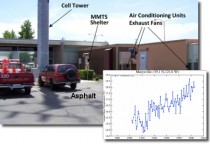
Enlarged
Since 80% of the network has compromised siting, the data used to infill is compromised.
It’s a real mess.
Anthony adds “So far just USA for this error, we don’t know about GHCN yet.”
ICECAP NOTE: I have posted that I had downloaded from NCDC Climate at a Glance the Maine state Annual temperatures in 2013 for a talk and it showed no warming since 1895! (the trend was shown as -0.03/decade). Well after NOAA announced a transition to the CLIMDIV version of USHCN at the end of this brutal winter, I decided to download the new plot. The new CLIMDIV data was supposed to resolve issues with recent station moves, transition to airport, to new MMTS technology and UHI and siting issues with improvements late in the record, we were very surprised to see the biggest changes to the early data set. 1913 went from the warmest year in the record to the middle of the pack with a cooling of close to 5F!. The log term average dropped over 1F. The long term trend rose to +0.23F/decade, the largest of the 50 states.
Basing government energy and tax policy on corrupted data ensures nothing but pain for only government gain.
Please help continue our work which has been pro bono. We are working behind the scenes to refute the false claims and comment back to the government oversight agencies and eventually the courts. Use the donate button in the left column. Any amount is appreciated.
January 29th, 2018 by Roy W. Spencer, Ph. D.
Global warming be damned - full speed ahead on the Maize Train.
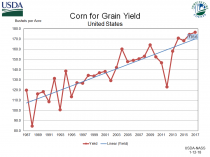
USDA Corn Yield
The numbers are in from USDA, and 2017 saw a new record in average corn yield, with 176.6 bushels per acre.
In fact, the last four growing seasons (2014, 2015, 2016, 2017) had higher yields than any previous years. The last time that happened was in 1964.
And compared to 1964, the U.S. is producing nearly three times as much corn per acre as we did back then.
There is no indication of a slowdown in the long-term upward trends in corn yields. While the 176.6 bpa U.S. average for 2017 is a huge increase compared to just 50 years ago, the latest winner for the highest yield produced by a single farmer has risen again to over 542 bpa, which is fully three times the U.S. average yield.
While the global warmmongers continue to wring their hands over rising temperatures hurting yields (the Corn Belt growing season has indeed warmed slightly since 1960), improved varieties and the “global greening” benefits of more atmospheric CO2 have more than offset any negative weather effects - if those even exist.
Globally, upward trends in all grain yields have been experienced in recent decades. Of course, droughts and floods cause regional crop failures almost every year. That is normal and expected. But there has been no global average increase in these events over the last century.
In his latest movie, Al Gore claimed just the opposite for wheat yields in China. While I hesitate to call him a liar, since I don’t know where he got his information - Gore was just plain wrong.
The sky is not falling. Life on Earth depends upon CO2, even though there is so little of it - now 4 parts per 10,000 of the atmosphere, compared to 3 parts a century ago. No matter how much we emit, nature gobbles up 50% of it.
Most of the evidence suggests that life is now breathing more freely than any time in human history, thanks to our CO2 emissions.
--------------
As much of America remains frigid, media headlines shout far and wide that catastrophic man-made climate change is to blame. But is it true?
What are the basic facts about climate that people need to know? Four questions can aid in the understanding of this complicated topic.
First, is the Earth warming?
Second, if it is, what is causing the warming?
Third, assuming that CO2 is causing the Earth to warm, what is the cost of mitigating its impact?
And fourth, if CO2 has little or no impact on the Earth’s temperature, can anything good come from future increases of CO2?
So is the Earth warming? Yes! The Earth is warming, and it has been for over 150 years as the world emerges from the Little Ice Age. Atmospheric CO2 has also been increasing since WWI.
What causes the warming? That is a matter of intense debate.
In the 1980s, meteorologists observed that the Earth’s temperature was increasing at the same time as atmospheric CO2 concentration was rising.
A group at NASA concluded that CO2 is driving the warming. They developed a numerical model of the atmosphere that projected an alarming rise in the Earth’s temperature and made public announcements of an impending disaster. All the alarmist statements from the 1980s until today are based on numerical models.
But beginning in 1998, the Earth’s temperature plateaued (currently referred to as the “pause") while CO2 levels continued to spiral upward. This caused a number of scientists outside the “alarmist” community to undertake an in-depth review of what has become a serious controversy.
These “skeptics” are convinced that meteorological data overwhelmingly show that CO2 is not a major factor in the global temperature. Their belief is based on three primary reasons.
First, the pause has lasted for nearly twenty years, while atmospheric concentration of CO2 continues to rise. Second, there is a poor correlation between CO2 and the Earth’s temperature, as evidenced by the current pause and the fact that what correlations exist often show that temperature changes before CO2 rather than vice versa. And third, failure of the numerical models, which predict double and triple the warming seen in real-world observations, suggests that the CO2 terms in the models are wrong.
Nevertheless, assuming that the alarmists are right and CO2 is causing global warming, what would be the cost to mitigate warming driven by CO2?
This brings us to the meeting of the U.N. Framework Convention on Climate Change in Paris in December 2015, when 194 nations agreed to reduce CO2 emissions by unrealistic amounts.
It was recognized that developing nations would need financial help to achieve their goals. The conference agreed to establish a “Green Climate Fund” that would be distributed to developing nations. The goal was to have $100 billion in this fund by 2020. Of the 194 countries, 46 agreed to be donor nations, which means there would be almost 150 receiver nations.
At the meeting, the 46 donor nations made an initial pledge of $10 billion, with 90% coming from six countries: England, France, Germany, Japan, Sweden, and the United States, with the U.S. carrying the heavy load of $3 billion. It was agreed that pledges would be paid in two years. Yet, two years later, only $3.4 billion has been collected, with over one fourth of it from the U.S.
In 2017, however, President Trump announced that the U.S. would pull out of the agreement. If we were to rejoin the Paris agreement, we would have to pay over $2 billion immediately to satisfy our pledge, and that would only be the beginning, because the goal is to have $100 billion in the “Green Climate Fund” by 2020. Without billions of dollars from the U.S., the Paris Agreement is doomed.
Bloomberg New Energy Finance estimates that it will cost the world $7.4 trillion by 2040, and Bjorn Lomborg estimates that it will cost from $70 to $140 trillion by 2100 if all nations comply with the Paris Agreement.
In addition, there have been billions of dollars spent domestically on global warming. The Capital Research Center estimated the United States spent $166 billion on global warming from 1993-2014, and the budgets for 2015-2017 were around $20 billion per year.
What does all this money buy us? Estimates assuming that CO2’s warming effect is large range to as much as a 1.5-degree centigrade reduction in global average temperature at the end of this century. But the most credible figure, generously based on the IPCC’s own assumptions of CO2’s warming effect, seems to be under 0.2 degrees centigrade. That is a lot of money for an insignificant result.
Finally, if the skeptics are right, and CO2 is not a major factor in the Earth’s temperature, warming prevented by the Paris agreement would be even less, though the costs would remain the same.
Meanwhile, can anything good come from expected future increases of CO2? The answer is a resounding yes!
We have known for years that CO2 enhances plant growth. Over 1,000 scientific studies on a variety of plants have documented this growth, but only recently has there been an attempt to put a monetary value on the increases.
Dr. Craig Idso, in a fascinating investigation, used the results of these studies to determine the growth rate of 45 plants for the period 1961-2011. These plants produce 95% of the food for the world’s population. He then converted this growth into a dollar value. For the fifty-year period ending in 2011, growth of plants by CO2 resulted in an increase of $3.2 trillion for the world’s agricultural community.
Dr. Idso then projected these results forward to 2050, assuming that CO2 would continue to increase at the current rate. The world could realize an astounding $9.8-trillion additional bonus!
The great news is that it costs nothing to achieve this goal. All we have to do is continue using fossil fuels at today’s rate.
In summary, the alarmists’ policies will cost trillions of dollars in a largely ineffectual attempt to mitigate warming, with no proof that mitigation is necessary and with current attempts proven to be utterly dismal. The skeptics’ solution will result in a return of trillions of dollars in increased agricultural growth and, more important, will allow developing countries to continue using abundant, affordable, and reliable energy sources - namely, fossil fuels - to rise and stay out of poverty and avoid the high rates of disease and premature death that invariably accompany it.
This article was originally published on American Thinker.
P.S. If you liked this article you might enjoy our Cornwall Alliance Email Newsletter! Sign up here to receive analysis on top issues of the day related to science, economics, and poverty development.




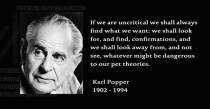
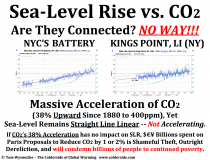
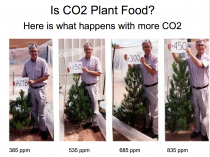
_thumb.png)
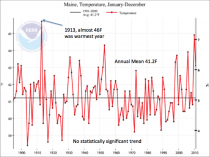
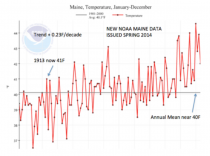
_thumb.gif)


